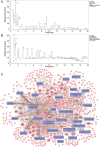Multi-Target Mechanism of Compound Qingdai Capsule for Treatment of Psoriasis: Multi-Omics Analysis and Experimental Verification
- PMID: 40546661
- PMCID: PMC12182737
- DOI: 10.2147/DDDT.S523836
Multi-Target Mechanism of Compound Qingdai Capsule for Treatment of Psoriasis: Multi-Omics Analysis and Experimental Verification
Abstract
Background: Psoriasis is a chronic skin disease affected by genetic and autoimmunity. The traditional Chinese medicine, Compound Qingdai Capsule (CQC), has shown potential benefits in treating psoriasis in clinical settings. Despite its efficacy, the molecular mechanisms underpinning its therapeutic action remain unclear.
Purpose: This study aimed to unravel the molecular mechanism of Compound Qingdai Capsule for psoriasis based on the psoriasis pathogenic pathway network, integrating multi-omics analysis, systems pharmacology, machine learning modeling, and animal experimentation.
Methods: Psoriasis pathogenic pathway network was constructed through employing bioinformatics analysis and psoriasis-related multi-omics data mining. The ingredients of CQC were detected by UPLC-MS/MS, and target prediction was performed by systems pharmacology. Machine learning, including Lasso regression, Random Forest, and Support Vector Machine (SVM), were utilized to screen core targets of psoriasis. Molecular docking was employed to evaluate the binding affinity between ingredients and core targets. The expression levels of core targets were determined using qRT-PCR and ELISA.
Results: Psoriasis-related datasets GSE201827 and GSE174763 were comprehensively analyzed to obtain 635 psoriasis-related genes. These genes were further enriched to elucidate signaling pathways involved, leading to the construction of psoriasis pathogenic pathway network. Utilizing UPLC-MS/MS, 29 main ingredients of CQC were characterized. CQC ingredients-targets network was constructed using these ingredients and their targets. Screening of CQC anti-psoriasis core targets using machine learning algorithm. Molecular docking confirmed good binding affinity between these targets and ingredients. Imiquimod (IMQ) induced psoriasis-like rat validated the anti-psoriasis effect of CQC by alleviating symptoms, reducing spleen and thymus index, and modulating the expressions of core targets at mRNA and protein levels.
Conclusion: CQC effectively modulates the expression levels of AURKB, CCNB1, CCNB2, CCNE1, CDK1, and JAK3 through various ingredients, such as astilbin, salvianolic acid A, and engeletin, via multiple pathways, thereby alleviating psoriasis-like symptoms.
Keywords: compound qingdai capsule; machine learning; molecular mechanism; psoriasis; systemic pharmacology.
© 2025 Qiao et al.
Conflict of interest statement
The authors report no conflicts of interest in this work.
Figures










Similar articles
-
Multi-omics and experimental validation reveal the mechanism of DanxiaTiaoban decoction in treating atherosclerosis.Phytomedicine. 2025 Aug 31;147:157216. doi: 10.1016/j.phymed.2025.157216. Online ahead of print. Phytomedicine. 2025. PMID: 40916281
-
Exploring the therapeutic mechanism of Miao nationality medicine Qijiao Shengbai capsule on leukopenia based on multi-omics, network pharmacology and experimental verification.Phytomedicine. 2025 Aug;144:156935. doi: 10.1016/j.phymed.2025.156935. Epub 2025 Jun 5. Phytomedicine. 2025. PMID: 40513324
-
Systemic pharmacological treatments for chronic plaque psoriasis: a network meta-analysis.Cochrane Database Syst Rev. 2017 Dec 22;12(12):CD011535. doi: 10.1002/14651858.CD011535.pub2. Cochrane Database Syst Rev. 2017. Update in: Cochrane Database Syst Rev. 2020 Jan 9;1:CD011535. doi: 10.1002/14651858.CD011535.pub3. PMID: 29271481 Free PMC article. Updated.
-
A Strategy based on Bioinformatics and Machine Learning Algorithms Reveals Potential Mechanisms of Shelian Capsule against Hepatocellular Carcinoma.Curr Pharm Des. 2024;30(5):377-405. doi: 10.2174/0113816128284465240108071554. Curr Pharm Des. 2024. PMID: 38310567
-
Systemic pharmacological treatments for chronic plaque psoriasis: a network meta-analysis.Cochrane Database Syst Rev. 2021 Apr 19;4(4):CD011535. doi: 10.1002/14651858.CD011535.pub4. Cochrane Database Syst Rev. 2021. Update in: Cochrane Database Syst Rev. 2022 May 23;5:CD011535. doi: 10.1002/14651858.CD011535.pub5. PMID: 33871055 Free PMC article. Updated.
References
MeSH terms
Substances
LinkOut - more resources
Full Text Sources
Medical
Miscellaneous

